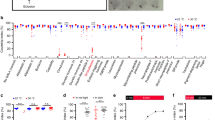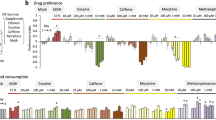Abstract
Both serotonin (5-HT) and neuropeptide Y have been shown to affect a variety of mammalian behaviors1,2,3, including aggression4,5. Here we show in Drosophila melanogaster that both 5-HT and neuropeptide F, the invertebrate homolog of neuropeptide Y, modulate aggression. We show that drug-induced increases of 5-HT in the fly brain increase aggression. Elevating 5-HT genetically in the serotonergic circuits recapitulates these pharmacological effects, whereas genetic silencing of these circuits makes the flies behaviorally unresponsive to the drug-induced increase of 5-HT but leaves them capable of aggression. Genetic silencing of the neuropeptide F (npf) circuit also increases fly aggression, demonstrating an opposite modulation to 5-HT. Moreover, this neuropeptide F effect seems to be independent of 5-HT. The implication of these two modulatory systems in fly and mouse aggression suggest a marked degree of conservation and a deep molecular root for this behavior.
This is a preview of subscription content, access via your institution
Access options
Subscribe to this journal
Receive 12 print issues and online access
$209.00 per year
only $17.42 per issue
Buy this article
- Purchase on Springer Link
- Instant access to full article PDF
Prices may be subject to local taxes which are calculated during checkout




Similar content being viewed by others
References
Lucki, I. The spectrum of behaviors influenced by serotonin. Biol. Psychiatry 44, 151–162 (1998).
Pedrazzini, T., Pralong, F. & Grouzmann, E. NPY: the universal soldier. Cell. Mol. Life Sci. 60, 350–377 (2003).
Carvajal, C., Dumont, Y. & Quirion, R. Neuropeptide y: role in emotion and alcohol dependence. CNS Neurol. Disord. Drug Targets 5, 181–195 (2006).
Popova, N.K. From genes to aggressive behavior: the role of the serotonergic system. Bioessays 28, 495–503 (2006).
Karl, T. et al. Y1 receptors regulate aggressive behavior by modulating serotonin pathways. Proc. Natl. Acad. Sci. USA 101, 12742–12747 (2004).
Kravitz, E.A. & Huber, R. Aggression in invertebrates. Curr. Opin. Neurobiol. 13, 736–743 (2003).
Yuan, Q., Joiner, W.J. & Sehgal, A. A sleep promoting role for the Drosophila serotonin receptor 1A. Curr. Biol. 16, 1051–1062 (2006).
Yuan, Q., Lin, F., Zheng, X. & Sehgal, A. Serotonin modulates circadian entrainment in Drosophila. Neuron 47, 115–127 (2005).
Wen, T., Parrish, C.A., Xu, D., Wu, Q. & Shen, P. Drosophila neuropeptide F and its receptor, NPFR1, define a signaling pathway that acutely modulates alcohol sensitivity. Proc. Natl. Acad. Sci. USA 102, 2141–2146 (2005).
Wu, Q., Zhao, Z. & Shen, P. Regulation of aversion to noxious food by Drosophila neuropeptide Y- and insulin-like systems. Nat. Neurosci. 8, 1350–1355 (2005).
Lee, G., Bahn, J.H. & Park, J.H. Sex- and clock-controlled expression of the neuropeptide F gene in Drosophila. Proc. Natl. Acad. Sci. USA 103, 12580–12585 (2006).
Baier, A., Wittek, B. & Brembs, B. Drosophila as a new model organism for the neurobiology of aggression? J. Exp. Biol. 205, 1233–1240 (2002).
Stevenson, P.A., Hofmann, H.A., Schoch, K. & Schildberger, K. The fight and flight responses of crickets depleted of biogenic amines. J. Neurobiol. 43, 107–120 (2000).
Dierick, H.A. & Greenspan, R.J. Molecular analysis of flies selected for aggressive behavior. Nat. Genet. 38, 1023–1031 (2006).
Monastirioti, M. Biogenic amine systems in the fruit fly Drosophila melanogaster. Microsc. Res. Tech. 45, 106–121 (1999).
Brand, A.H. & Perrimon, N. Targeted gene expression as a means of altering cell fates and generating dominant phenotypes. Development 118, 401–415 (1993).
Li, H., Chaney, S., Roberts, I.J., Forte, M. & Hirsh, J. Ectopic G-protein expression in dopamine and serotonin neurons blocks cocaine sensitization in Drosophila melanogaster. Curr. Biol. 10, 211–214 (2000).
Coleman, C.M. & Neckameyer, W.S. Serotonin synthesis by two distinct enzymes in Drosophila melanogaster. Arch. Insect Biochem. Physiol. 59, 12–31 (2005).
Lundell, M.J. & Hirsh, J. Temporal and spatial development of serotonin and dopamine neurons in the Drosophila CNS. Dev. Biol. 165, 385–396 (1994).
Friggi-Grelin, F. et al. Targeted gene expression in Drosophila dopaminergic cells using regulatory sequences from tyrosine hydroxylase. J. Neurobiol. 54, 618–627 (2003).
Suster, M.L., Martin, J.-R., Sung, C. & Robinow, S. Targeted expression of tetanos toxin reveals sets of neurons involved in larval locomotion in Drosophila. J. Neurobiol. 55, 233–246 (2003).
Nilsen, S.P., Chan, Y.B., Huber, R. & Kravitz, E.A. Gender-selective patterns of aggressive behavior in Drosophila melanogaster. Proc. Natl. Acad. Sci. USA 101, 12342–12347 (2004).
Vrontou, E., Nilsen, S.P., Demir, E., Kravitz, E.A. & Dickson, B.J. fruitless regulates aggression and dominance in Drosophila. Nat. Neurosci. 9, 1469–1471 (2006).
Ferveur, J.F., Stortkuhl, K.F., Stocker, R.F. & Greenspan, R.J. Genetic feminization of brain structures and changed sexual orientation in male Drosophila. Science 267, 902–905 (1995).
Karess, R.E. & Rubin, G.M. Analysis of transposable element function in Drosophila. Cell 38, 135–146 (1984).
Slemmon, J.R., Salvaterra, P.M., Crawford, G.D. & Roberts, E. Purification of cholineacetyltransferase from Drosophila melanogaster. J. Biol. Chem. 257, 3847–3852 (1982).
Lindsey, J.W., Jung, A.E., Narayanan, T.K. & Ritchie, G.D. Acute effects of a bicyclophosphate neuroconvulsant on monoamine neurotransmitter and metabolite levels in the rat brain. J. Toxicol. Environ. Health A 54, 421–429 (1998).
Cransac, H., Cottett-Emard, J.-M., Pequignot, J.M. & Peyrin, L. Monoamines (norepinephrine, dopamine, serotonin) in the rat medial vestibular nucleus: endogenous levels and turnover. J. Neural Transm. 103, 391–401 (1996).
Hoffmann, A.A. The influence of age and experience with conspecifics on territorial behavior in Drosophila melanogaster. J. Insect Behav. 3, 1–12 (1990).
Acknowledgements
We thank J. Sullivan for help with behavioral analysis, D. Robinson for technical assistance, R. Johnson for 5-HT analysis by HPLC and B. van Swinderen, R. Andretic and S. Pangas for comments on the manuscript. We also thank P. Shen (University of Georgia) for the npf-GAL4 stock and T. Stone (University of California, San Diego) for generating the UAS-dTrh transformants. Ddc-GAL4/TM3, Ser and Th-GAL4/TM3, Ser were provided by J. Hirsch (University of Virginia). UAS-TNT was provided by U. Heberlein (University of San Francisco). This material is based on work supported by the US National Science Foundation under grant number 0432063 (R.J.G. and H.A.D.). R.J.G. is the Dorothy and Lewis B. Cullman Fellow at The Neurosciences Institute, which is supported by the Neurosciences Research Foundation.
Author information
Authors and Affiliations
Contributions
This study was designed by H.A.D. and R.J.G. H.A.D. performed the experiments, analyzed the data and wrote the manuscript.
Corresponding author
Ethics declarations
Competing interests
The authors declare no competing financial interests.
Supplementary information
Supplementary Fig. 1
Escalating flies and aggression measurement. (PDF 56 kb)
Supplementary Fig. 2
Schematic of 5-HT synthesis. (PDF 22 kb)
Supplementary Fig. 3
Linear regression plot of fighting frequencies of treated and untreated lines. (PDF 28 kb)
Supplementary Table 1
Gene products involved in 5-HT function and their mammalian homologs. (PDF 14 kb)
Rights and permissions
About this article
Cite this article
Dierick, H., Greenspan, R. Serotonin and neuropeptide F have opposite modulatory effects on fly aggression. Nat Genet 39, 678–682 (2007). https://doi.org/10.1038/ng2029
Received:
Accepted:
Published:
Issue Date:
DOI: https://doi.org/10.1038/ng2029
This article is cited by
-
Serotonin signaling regulates actomyosin contractility during morphogenesis in evolutionarily divergent lineages
Nature Communications (2023)
-
Effects of lithium on aggression in Drosophila
Neuropsychopharmacology (2023)
-
Drosophila mutants lacking the glial neurotransmitter-modifying enzyme Ebony exhibit low neurotransmitter levels and altered behavior
Scientific Reports (2023)
-
Chemical cognition: chemoconnectomics and convergent evolution of integrative systems in animals
Animal Cognition (2023)
-
Increased histone acetylation levels or a serotonin precursor reinstate the context memory impaired by the serotonin receptor blocker methiothepin
Neuroscience and Behavioral Physiology (2023)



